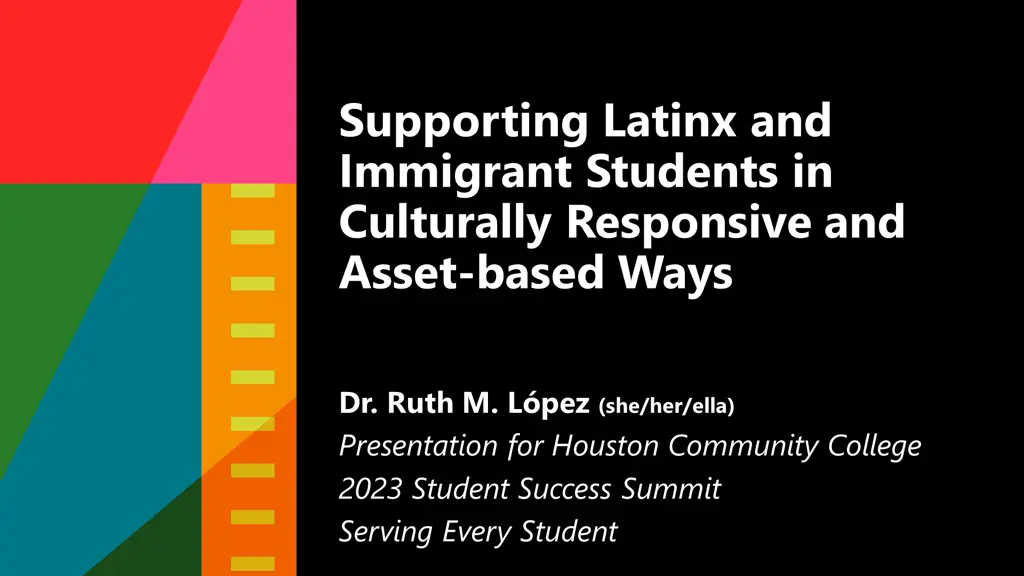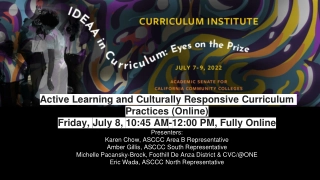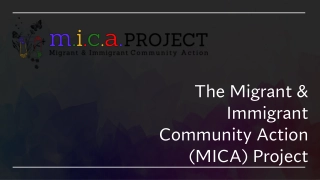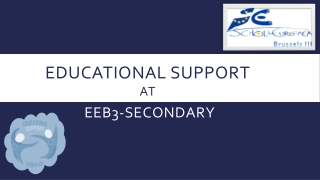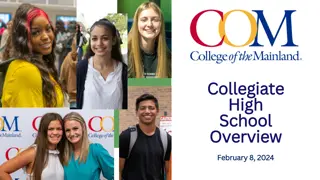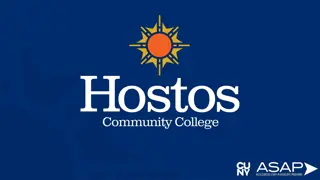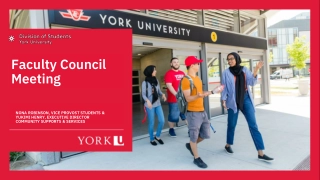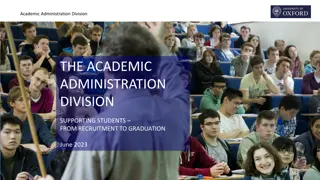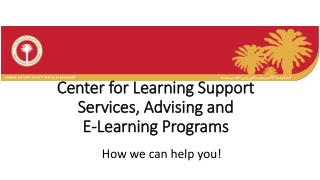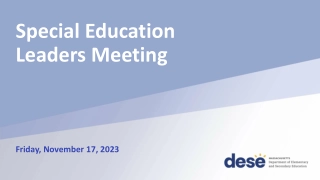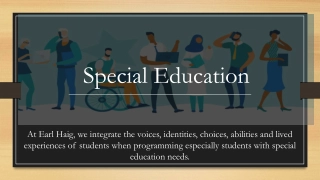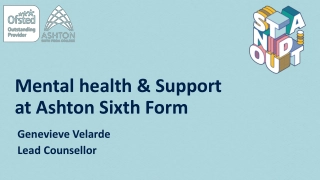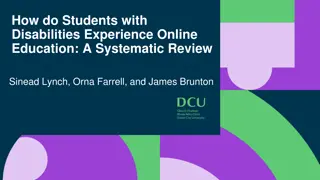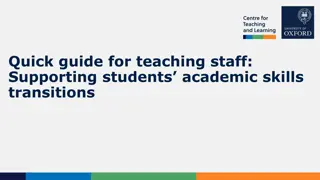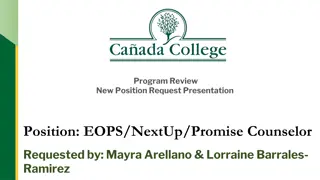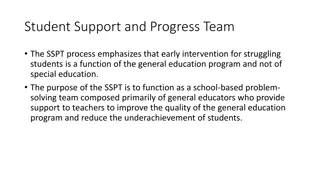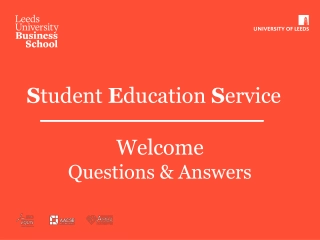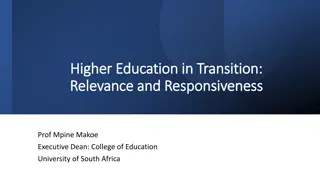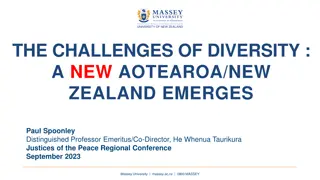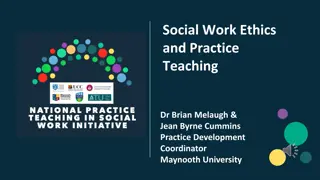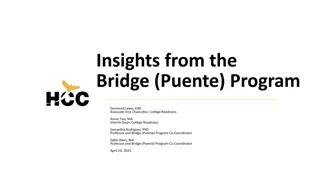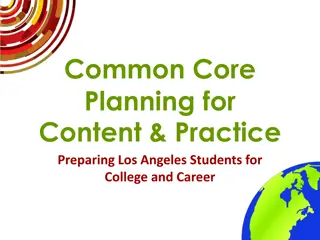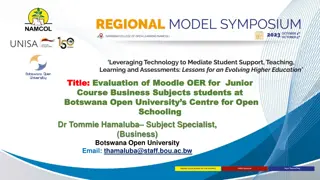Culturally Responsive Support for Latinx and Immigrant Students
Dr. Ruth M. López discusses valuable approaches at HCC's 2023 Student Success Summit. Hear insights on immigration policies, education, and enhancing student experiences. Learn from her research on Latinas in higher education and more.
Download Presentation
Please find below an Image/Link to download the presentation.
The content on the website is provided AS IS for your information and personal use only. It may not be sold, licensed, or shared on other websites without obtaining consent from the author. Download presentation by click this link. If you encounter any issues during the download, it is possible that the publisher has removed the file from their server.
Presentation Transcript
Supporting Latinx and Immigrant Students in Culturally Responsive and Asset-based Ways Dr. Ruth M. L pez (she/her/ella) Presentation for Houston Community College 2023 Student Success Summit Serving Every Student
Agenda 1. 2. 3. My Background & Research Intersection of Immigration Policy & Education Excerpts From Two Studies: Latina Pre-College Experiences Questions 4.
Who I Am Daughter of formerly unaccompanied immigrant adolescent from El Salvador Salvadoran Mother came to the U.S. at age of 17 in 1977 Mexican Father came to the U.S. at 17 in 1976 Mexican Grandfather was a guest worker/bracero during WWII Personal understanding of migrations that occur within a global historical and sociopolitical context Former English Learner educated in Dallas schools Former youth leader engaged in Latinx organizations First-generation everything Mother of school age children
P-20 Practitioner & Research Experience [2004-Present] College Outreach Counselor/Assistant Director University Outreach Centers Houston (UT-Austin) Served Houston middle and high schools Coordinator & Graduate Researcher for STEM Diversity Colorado Diversity Initiative (CU-Boulder) High School STEM Study (NSF) Senior Research Associate Annenberg Institute for School Reform (Brown University) Mixed-methods & collaborative evaluations with districts and state education in Massachusetts, Rhode Island, and California Assistant Professor K-12 Educational Leadership & Policy Studies (University of Houston) P-20 Research & Engagement
Some of My Research The intersection of immigration policies and education Critical Discourse Analysis of TV news coverage of the DREAM Act of 2010 Critical analysis of policies impacting education of unaccompanied children College access for nondominant students and diversity in higher education Latinas in higher education (P-20) Latinx community college students
Intersection of Immigration Policy & Education
[Humanizing] Words Matter Unauthorized Undocumented Immigrant/Migrant Children/Youth/Adolescents Mixed-Status When in doubt, ask
Immigrant & Children of Immigrants in US Between 11-11.5 million unauthorized immigrants in the United States Top five states: California, Texas, New York, Illinois, & Florida 2.1 million under 18 years of age 4.6 million 16-34 years of age 3.5 million U.S. citizen children under age 18 with at least one undocumented immigrant parent Source: Migration Policy Institute and Pew Hispanic Research Center
Texas Context Unauthorized population estimate: 1,739,000 Harris County: 481,000 Top regions of birth: Mexico, El Salvador, Honduras, Guatemala (88%) Parents of U.S. citizens: 587,000 Harris County: 157,000 Undocumented Texas children and youth Under 16: 107,000 Ages 16-24: 257,000 Source: Migration Policy Institute tabulation of data from the U.S. Census Bureau's pooled 2015-2019 American Community Surveys.
Undocumented Student Policies Timeline 1982 Plyler v. Doe Undocumented students gained the right to a K-12 education Includes unaccompanied immigrant children 2001 DREAM Act first proposed in the US senate Lived here 5 years; attend college or join military; no criminal background. 2001-Present State DREAM Acts. 2001: Texas in-state tuition bill HB 1503/SB 1528, access to in-state tuition rates 2012 Deferred Action for Child Arrivals (DACA) Later challenged by Trump administration Present: Undocumented HS students graduating with no access to DACA
Challenges: K-12 & Higher Education Confusing policies, lack of policy information, backlash against inclusive policies Anti-immigrant climate and deficit views of students Students/families fearful of sharing, educators fearful of speaking openly Some institutions impede enrollment for undocumented students Require documents not necessary for enrollment, such as SS Segregation and tracking of youth Do undocumented students have access to pre-college and dual-enrollment classes? Deficit-based educational approaches and perspectives Are students' languages and cultures valued? Assumptions about who undocumented students are/are not Race, ethnicity, language, etc. What other challenges exist?
Some Recommendations Acknowledge privileges For me, although I m Latina and daughter of immigrants, I was born in the U.S. and have many privileges due to this Partner with immigrant rights organizations I always lead with I am not an immigration attorney, but I know a lot of them. Understand that every immigrant student may have a unique story - Age at time of arrival, legal status, family make-up, previous schooling, language, etc. K-12 partnerships are key it takes time to establish trust with families, & this will be needed to complete enrollment and Texas financial aid form (TASFA) and enrollment 12
More Recommendations Complete college/campus-wide assessments of inclusion of undocumented students surveys, messaging, websites, fliers Understand transfer and employment requirements including information about graduate school Establish undocumented student resource centers can serve as a way to train staff and student leaders. There are lots of models out there even in Texas! Check out NASPA Undocumented Immigrants and Allies Knowledge Community! @NASPAUndocuKC on Twitter
Reflection to Consider Imagine what a school [college] culture and climate might look like that provides a safe and supportive environment for all students including undocumented, unaccompanied Indigenous youth, and mixed-status [and even staff]. What structures would need to be in place to support that environment? What is your role in supporting that environment? What other factors should be included-considered when cultivating and maintaining this positive school [college] culture? From L pez & Fernandez (2020) Source: L pez, J., & Fern ndez, E. (2020). You never know when you will see him again : Understanding the intersectional dimensions of immigration, indigeneity, and language for unaccompanied indigenous minors. Journal of Cases in Educational Leadership, 23(1), 5-20.
The Uncertain Path Toward College: How Intersectionality Shaped the Experiences of Latinas Enrolled at a Hispanic-Serving Institution
Study Background Research Question: How did intersectional experiences shape the educational trajectory of Latina undergraduates enrolled at an HSI? Longitudinal qualitative study of Latina college students at a 4-year Hispanic-Serving Institution Educational experiences Latinas had during high school as they considered their college path, when enrolling in an HSI, and during college. L pez, R. M., Honey, M. L., Rendon, S., & P rez- Gill, S. (2022). The Uncertain Path Toward College: How Intersectionality Shaped the Experiences of Latinas Enrolled at a Hispanic-Serving Institution. AERA Open, 8.
Literature Review Latina enrollment at Hispanic-Serving Institutions Proximity to home (Carales & L pez, 2020; Contreras & Contreras, 2015) Supportive role of family and community (Kiyama & Rios-Aguilar, 2017; Matos, 2015) Face stereotypes based on multiple marginalized identities, but resist oppressive contexts with community (P rez Huber, 2009; Yosso, 2005). Critical perspectives on the role of HSIs Examine servingness beyond enrollment (Contreras et al., 2008; Cuellar, 2019; Garcia et al., 2019; S. Hurtado & Ruiz Alvarado, 2012; Santiago, 2012) Disrupting traditional measures of excellence and academic success such as persistence rates and full-time enrollment to better serve Latinx students (Cuellar et al., 2017; Doran, 2015; Garcia & Okhidoi, 2015).
Data Collection & Participants Face-to-Face & Virtual Interviews from Fall 2017 to Fall 2021 98 interviews for 25 participants across 3 cohorts 25 Student Participants 7 Central American (Salvadoran, Nicaraguan, and Guatemalan) 18 Mexican/Mexican-American 20 daughters of immigrants 8 held DACA status 23 first-generation college students
Immigration and Precollege Experiences Isabella, a pre-med student in Summer 2019 shared: Sophomore year I found out I m a DACA student. So, that s when I started finding out, Oh, you know, what kind of college can I go to? How am I going to pay for college? Scholarships? And that s when I kind of started feeling . . . like I wasn t sure if I going to college or not. I felt very scared. I didn t know what to do, and even though it was a mostly all-Hispanic high school, there wasn t enough resources or enough information that they could give me. I did my own research for finding scholarships. And I think being a first-generation Latina and coming to college has been tough because my parents don t understand sometimes.
Intersectionality & Precollege Experiences JuJu, a community college transfer student and daughter of immigrants from El Salvador: I won the [English honors] award too. You know, I was really happy. At the same time, I was kind of sad because I . . . special ed students, they don t treat them like, you know, like you could be up there. I felt like I was never going to be an honors student. I felt like I was not going to go to college, because in my mind, I mean, I have people say, Well, you re in special ed. You know, you can t do this, you can t do that. (Summer 2019) I was not thinking about college. And that [role model] is my dad because he went to school, but that s another story. So, he helped me with my math homework when I was little. But, you know, once math advances more, it s totally different [from] how it is in other countries. And it s not in Spanish. Everything s going to be in English. There s no way he can teach me. And he helped me. I remember he would have his orange fruits or pencils. You know, how you help your kid try to solve a math problem. He d sit down and help me with that.
Counter-stories In the fall of 2019, Giselle, who was a first-generation college student who attended a high school with majority students of color, shared the following about her high school experience: [I]t wasn t the best high school, but there was a lot of potential in that building. I can probably say I m an example of that, and my friends are an example of that. Our valedictorian got accepted to [private universities], and so there [were] a lot of people with so much potential to be great people. It was just one of those things that we all had to believe in ourselves, because the community outside didn t believe in us. It made me just that much prouder of everything that I did, because I appreciated it just that much more, because I came from a school that didn t have a lot of funding. We didn t have state-of-the-art computers, nothing like that. We were all still succeeding regardless of all of that.
Discussion Identified how multiple forms of oppression and social identities shaped the high school experiences of Latinas and learned how they found belonging at an HSI by finding spaces and individuals who validated their intersectionality. Demonstrate why Latina student intersectionality prior to enrolling in college is important for researchers and educational leaders to consider.
Examining the Educational Experiences of Latina Early College High School (ECHS) Students
Methods Longitudinal Qualitative Study Structured interview protocol via Zoom Fall 2020 Interview N=12 [7 Latinas] Fall 2021 Interview N=11 [7 Latinas]
Participant Demographics Latinas All 7 Latinas were daughters of Mexican immigrants All 7 shared that Spanish was their first language and were labeled English learners in school All first-generation college students 6 of 7 were enrolled full-time in college at time of second interview 5 in four-year university 1 in community college 1 working full-time 1 student had DACA status
Findings 1. Family support they received in elementary and middle school influenced their decision to enroll at an academically rigorous ECHS; 2. Choosing to attend an ECHS not an individual decision, but rather one informed by their family and community; and 3. Institutional agents at Eagle ECHS who served as sources of strength that helped students succeed through this rigorous program and become college ready.
Community Cultural Wealth & Critical Resilience in Elementary School Laura conveyed how she and her mother navigated the educational system while learning English: There was a bilingual class, but it was too full. So, they gave me another teacher, and she didn t know Spanish that well. So, I kind of struggled there, and I kind of gave up on trying to find a figure to look up to teach me the English. So, what my mom would do, she would just go to the thrift store, garage sales, and we would buy books in English, and I would just learn to read it So, I would say my mom was a big aspect that helped me learn English. Even though she didn t know the language herself, she knew how vital it was to know it in America. So, she consistently proved that through her efforts to get me to learn it. (Laura, interview, 12/01/2020)
Critical Latina Student Agency Maggie discussed the skills she learned as a language broker (Orellana, 2009) and later applied in her college courses: Eagle EHCS taught me how to mature early; how to grow faster than I was supposed to. I was taking college classes at the age of 14, which most people don t do. So, I definitely had to grow up faster than everybody else. It s not something I was not used to doing. I felt like I always had to grow up a little bit faster because my parents depended on me translating and everything like that. So, it s not something that I wasn t used to, but it s definitely something that did impact my experience at Eagle ECHS. (Maggie, interview, 11/17/2020)
The Role Institutional Agents Alex shared that a formerly undocumented teacher told her about scholarships for people who are DACA students or who are just undocumented in general, talked to me about, instead of applying for FASFA, to apply for TASFA, stuff like that. I really did think that the financial part would be the one that would stop me, but she just said that there s a lot of grants out there, and there is. Because of her I realized like I can do it if I just keep applying myself. (Alex, interview, 11/16/2020)
Conclusion & Implications By including Latinas educational journeys from elementary school to college, we revealed how they leveraged their earlier experiences to succeed in higher education Important to look at Latinas along their educational life course because elementary and middle school experiences for Latina students can determine whether they have access to college. Family engagement is key not only in K-12, but also in higher education. Families have been engaged since early education, and it means a lot to stay engaged.
Returning to Our Reflection Imagine what a school [college] culture and climate might look like that provides a safe and supportive environment for all students including undocumented, unaccompanied Indigenous youth, and mixed-status [and even staff]. What structures would need to be in place to support that environment? What is your role in supporting that environment? What other factors should be included- considered when cultivating and maintaining this positive school [college] culture? From L pez & Fernandez (2020) Source: L pez, J., & Fern ndez, E. (2020). You never know when you will see him again : Understanding the intersectional dimensions of immigration, indigeneity, and language for unaccompanied indigenous minors. Journal of Cases in Educational Leadership, 23(1), 5-20.
Thank you! Questions? Contact me at : RMLopez3@uh.edu
Critical Latina Student Agency (CLSA) Allowed us to examine the contexts and college-going experiences of Latina students from an asset-based perspective as well their multiple social identities and systems of power they navigate Identified their agency across various environments Outer Level: Systems of Power Middle Level: Sources of Strength Inner Circle: Critical Resilience
Theoretical Framework Chicana Feminist Epistemology (Calder n et al., 2012; Delgado-Bernal, 1998; J. Flores & Garcia, 2009; A. Hurtado, 2003) Challenges the notion of objectivity in educational research, acknowledges the differences of Chicanas lived experiences, and presents women s intuitions as valid sources of knowledge. Intersectionality (Collins, 2015; Crenshaw, 1991; A. Hurtado, 2018; Zambrana & Hurtado, 2015) Examine how multiple forms of oppression (e.g., racism, classism, sexism, nativism, and ableism) shaped Latina students educational experiences from high school to college. Multilevel model of intersectionality for college access and success of Latinos in higher education (N ez, 2014).
